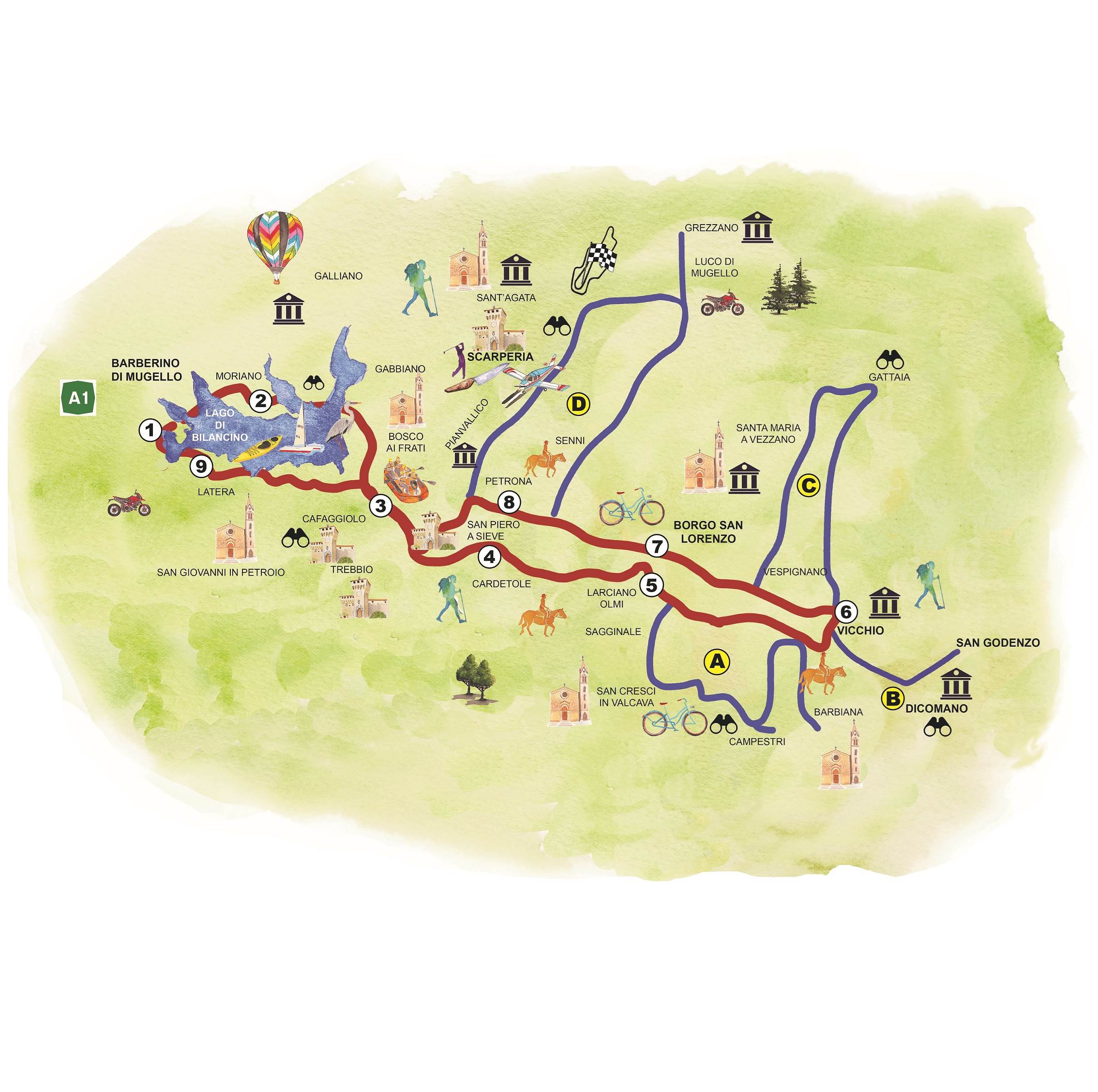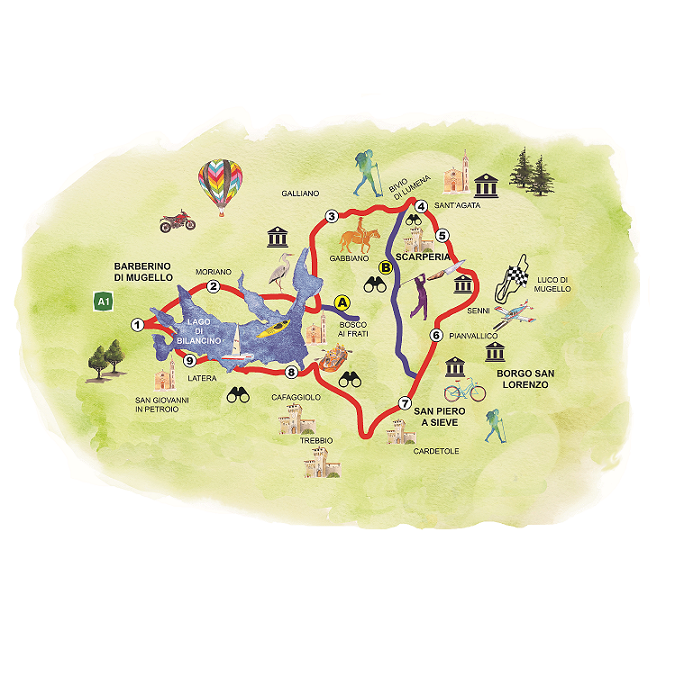Discover Mugello
Itinerary 3
The great outdoors
Follow the numbers on the map to recreate this itinerary and find our suggestions for activities, cultural points of interest, gastronomy, and accommodations below. The red route is the main itinerary but you can stop along the blue route detours to further discover the area.
2. Montecarelli - Santa Lucia - Monte di Fo
3. Passo della Futa
4. Traversa - Faggiotto - Covigliaio
5. Paliana
6. Firenzuola
7. Castro San Martino - Sigliola - Cornacchiaia
8. Le Maschere - Montecarelli
Detours
A. Panna - Galliano - Lake Bilancino
An integral part of Mugello, the Apennines form its northern frame and, on the side bordering with Romagna, they cover the small mountain valley of Firenzuola, center of the so-called Alto Mugello.
From the entrance of the A1, cross the center of Barberino along Via della Repubblica, parallel to the short and today pedestrianized Corso Bartolomeo Corsini, a medieval road that in the past was crowded with artisans, then take SP 8 “della Ruzza” named from the valley that flanks it, with the beautiful village of Cirignano. At the Montecarelli crossroads, take the SS 65, “la Bolognese,” a sinuous road which, winding along an open landscape, connects Florence to Bologna through Passo della Futa. Montecarelli, then Santa Lucia and Monte di Fò are the first hamlets that accompany us to the pass, which is reached after a series of wonderfully steep bends, which are the prelude to a change in nature and atmosphere.
In fact, between meadows and pine forests, you will reach 903 meters of the pass, announced by the imposing pyramid wall of the Germanic Military Cemetery, where over 30,000 German soldiers who died in Italy during WWII are buried. A guardian who stands solemnly among the breathtaking views of the Firenzuola valley. Here nature is sovereign, it is strong: pure beauty. Along “la Bolognese” passing through Traversa, Faggiotto, Covigliaio, clusters of houses cling to the slopes of the mighty peaks of Sasso di Castro and Monte Beni, places that seen forgotten by tourism, are a silent retreat, dotted with second homes with mountain architecture. The Oasi Naturalistica di Covigliaio nature reserve in Faggiotto, with its marked paths and natural springs, allows you to relive the ancient nature of this area, where trekking and biking routes are intertwined today in paths known as “Via degli Dei,” which connects Bologna to Florence. Together with Via degli Dei you’ll also find lesser-traveled itineraries such as the ancient Citerna-Boccadirio path, as well as the Flaminia Militare, a Roman road discovered in the late 1970s, also used by the hamlet of L’Apparita, which slightly precedes the Passo della Futa. Before Passo della Raticosa, on the right, choose the descent towards Firenzuola, through Paliana: from here, the presence of man becomes one with the scenery with small, qualified farms and riding stables, crops, and tractors at work.
We then arrive in Firenzuola, a gateway between Tuscany and Romagna, as well as the place of origin of pietra serena, a grey sandstone used both in architecture and in art, as recounted in the small dedicated museum. Going up the Apennine coast along the SP 116, a secondary road which passes through tiny hamlets such as Castro San Martino, Cornacchiaia, whose Romanesque church is worth a visit, takes us back to Passo della Futa in a loop, with the frame of the mountains, from the Sasso di Castro to the Passo della Raticosa on the right-hand side.
From the Futa, then you go down to the left towards Barberino. The dilemma presents itself at Santa Lucia. Should we continue up to Lake Bilancino through the ups and downs of “la Bolognese,” between stately residences and well-kept farmhouses, up to Le Maschere, with its sixteenth to eighteenth-century villa of the same name? Or should we turn left and reach the east side of the lake, where you can take advantage of the waters of the Panna spring, relax in the chestnut groves that extend up to Galliano, visit the local wildlife oasis or, again, the Convent of Bosco ai Frati, with its naked Christ possibly of Donatello? It’s an arduous choice, but best to rely on your own instinct. In season, the rugged area of Panna is a destination for mushroom and truffle hunters. If you arrive at the lake at sunset via Villa Le Maschere, you are welcomed from a landscape that is tinged with unexpected colors. In any case, both choices are winning ones.
Whichever route you choose, you’ll glide gently towards the lake, along Via Gastone Nencini to the south which, at the Cafaggiolo roundabout leads to an unexpected tunnel. Followed by yet another succession of curves, there are rest areas that offer enchanting views of Lake Bilancino. Here the lake appears and disappears behind the green vegetation that surrounds its banks, marking the natural arrival point of an itinerary as tortuous as it is evocative.
Activities & Views
There’s so much to see and do in one visit, but any trip to Mugello should include a few of the following ideas
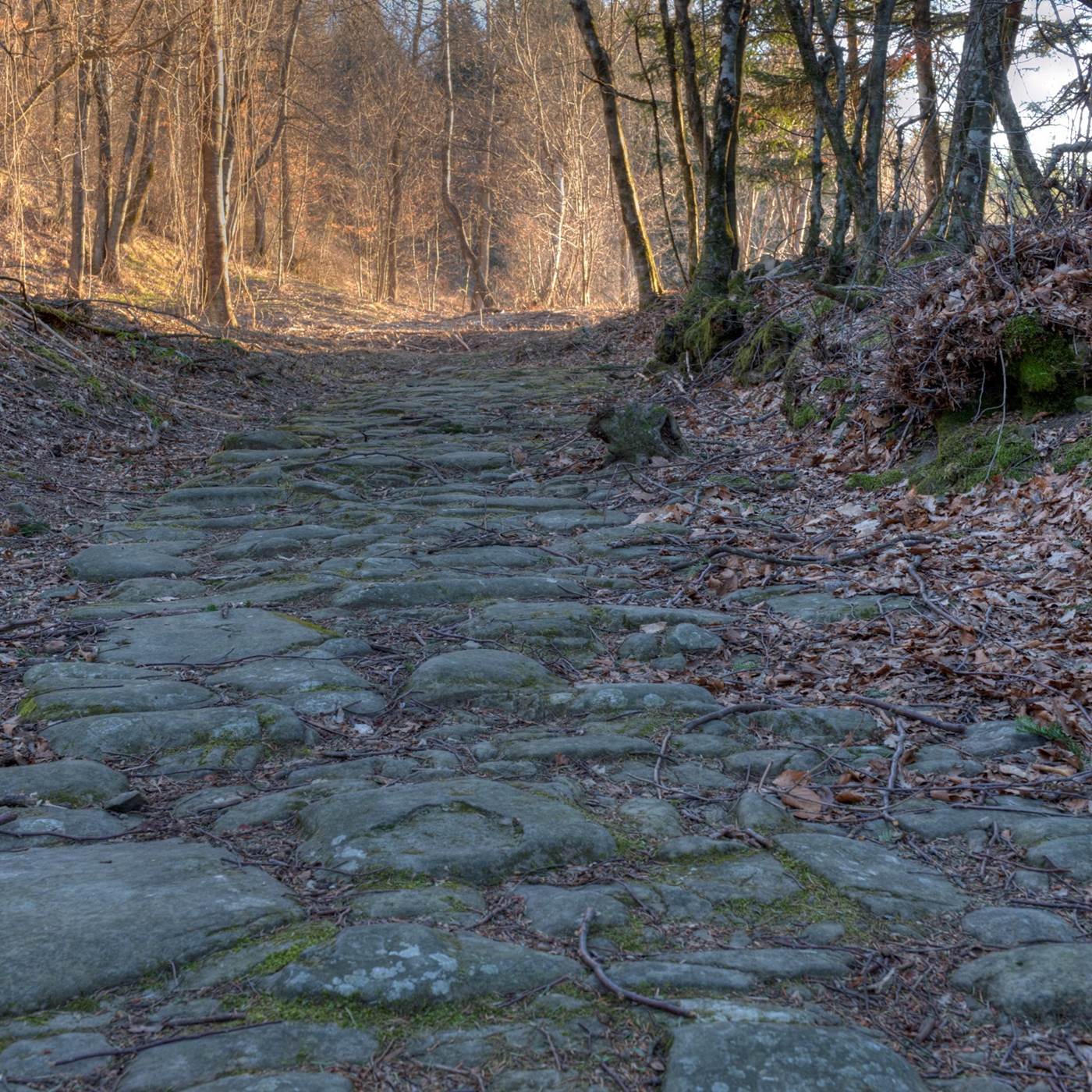
Extending over 800 hectares, the Oasi embraces the territory between Passo della Futa and Passo della Raticosa. In particular, the central part includes the areas around the Sasso di Castro, Monte Rosso, Monte Freddi, and Monte Beni mountains, all of which are around 1,300 mt. high. The whole area is of considerable naturalistic interest both in terms of flora and fauna and is suitable for excursions as it is equipped with trails of varying difficulty.
Cultural Points of Interest
History and culture are deeply rooted in Mugello
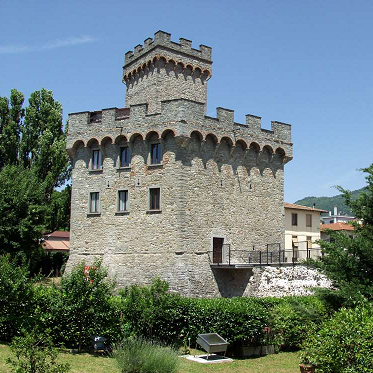
Via di Castello 8, 50031 Barberino di Mugello
The castle dates back to year 1000 as a Lombard lookout tower. Initially, it was the heart of the village of Barberino with numerous houses that sought protection in its vicinity. Today the castle organizes events, guided tours, and aperitifs by reservation.
German Military Cemetery
Passo della Futa
Inaugurated in 1969, it is located exactly in the middle of the long German defense line, called the Gothic Line. Extremely rigorous in its function of remembrance and warning, devoid of any warlike rhetoric. It is the largest German cemetery in Italy. Designed with a spiral shape, it seems to move towards the memorial, surmounted by the symbolic "splinter."
Church of San Matteo in Covigliaio
Via Nazionale 1, 50033 Firenzuola
The church is in a mountain context on the edge of the homonymous road that crosse the village up to Pietramala. The neo-Gothic church has a gabled facade, exposed Alberese stone, a Latin cross plan with a vaulted nave culminating in a raised presbytery, a retangular apse, and 2 chapels on the sides of the transept.
City centre of Firenzuola
Located beyond the Apennine mountain pass between Bologna and Firenze, the town was built in 1350 by the Florentine Republic. Firenzuola was almost completely destroyed after WWII. Today it is the idea place for nature lovers who prefer the relaxing silence of the uncontaminated woods and lush fields for long treks on foot, by horseback, or by bike.
Pietra Serena Museum
Piazza Don Stefano Casini 4, 50033 Firenzuola
Pietra Serena, the local grey sandstone, has been used for centuries to decorate square, Florentine palazzos, and religious and municipal monuments throught the territory. To preserve the history of stone making, the cellars of the Rocca fortress are now home to the museum.
Gastronomy
A selection of restaurants, trattorias, pizzerias, and much more where you can enjoy a real taste of Tuscan cuisine

Ristorante Piccola Firenze
Piazza Angolo 18, 50033 Firenzuola
Restaurant that specializes in Tuscan and Emiliano-Romagnola dishes cooked with passion using only local and seasonal products. They offer some of the famous dishes of Mugello cuisine such as hand-made potato tortelli and various meat-based and locally produced products. Each season there are new specialities, for example, during the fall and winter, porcini mushrooms become the protagonists of the menu.
Ristorante Le Maschere Enoteca
Via Nazionale 70, 50031 Barberino di Mugello
Surrounded by grenery, this restaurant has a splendid summer veranda and an elegant indoor area. Its location near Lake Bilancino is convenient for relaxing trips in the area. The dishes are in harmony with great wines. In fact, there is a wine cellar with over 300 of the most prestigious labels to choose fom.
Azienda Agircola Da Pagliana
Via Palliana le Macchie 278B, 50033 Firenzuola
Farm that specializes in organic poultry, breeding of organic Limousine cattle, and organic farming of chamois goats and Sardinian sheep for the production of raw milk, meats, and cheese. In collaboration with "Officina dei Sapori," they have also created an organic and artisanal soap and body cream line from goat milk.
Accommodations
A selection of some of the best hotels, agritourisms, resorts, and B&Bs along this itinerary
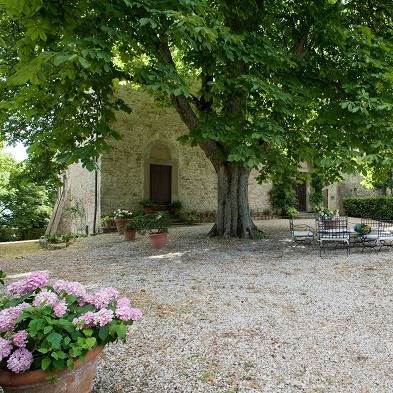
Located in a hilly area of the Mugello countryside, within an organic farm, Agriturismo Corzano is a quiet and panoramic village consisting of several farmhouses that date back to the 1600s. The certified organic farn since 2000, maintains the characteristic of the traditional Mugello farm and produces lavender, pure saffron, extra virgin olive oil, and craft beer.
Villa Panzano
Via Panzano 13, 50031 Barberino di Mugello
Belonging to the Archbishop of Florence, it was then passed to the Guasconi family and renovated in the 1500s. It is a villa of great historical importance that underwent a careful renovation, respecting its ancient forms and artistic beauty. This large villa can now accommodate up to 9 guests and has a private pool. It is completely immersed in the Mugello countryside for a relaxing stay.
Via Montecarelli 41, 50031 Barberino di Mugello
Camping il Sergente
SR 65 della Futa, 50031 Barberino di Mugello
Located in Monte di Fò, on the Tusccan-Emilian Apennines, Il Sergente is for lovers of outdoor holidays where you can fall asleep under the stars, trek in the midst of nature, and dedicate yourself to sports. It is open all year round and has well-shaded grass pitches that can accommodate campers, tents, and caravans. For hikers, there are 2 shelters that have 8 and 10 beds respectively. There is also the possibility of staying in apartments and mobile homes.
Mugello landscape photos by Christian Ghelardini
Watercolor maps by Lisa Brancatisano
Photos of hotels, restaurants, and activities provided by each entity
Read next




















